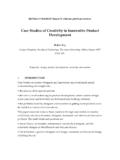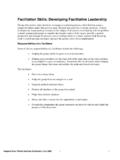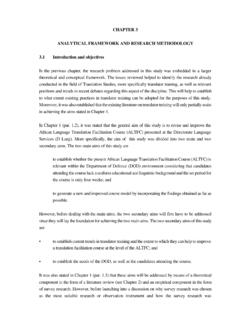Transcription of Open Research Online
1 Open Research OnlineThe Open University s repository of Research publicationsand other Research outputsKey operations performance factors on trade andtransport facilitationConference or Workshop ItemHow to cite:Batista, Luciano (2009).Key operations performance factors on trade and transport : LogisticsResearch Network Conference, 09-11 Sep 2009, Cardiff, guidance on citations see 2009 The AuthorVersion: Accepted ManuscriptLink(s) to article on publisher s website: and Moral Rights for the articles on this site are retained by the individual authors and/or other copyrightowners. For more information on Open Research Online s data policyon reuse of materials please consult the operations performance factors ON trade AND TRANSPORT facilitation Luciano Batista The Open University Business School Introduction Globalisation has dramatically changed logistics and supply chain management, demanding tightened operations and stronger management.
2 Despite the current financial crisis, global trade is likely to carry on growing, as greater participation in international trade has long been identified as an essential element of economic growth, generating mutual benefits for the countries and businesses involved. The facilitation of trade and transport is therefore critical for countries that want to harness globalisation s new opportunities for development (Appels and de Swielande, 1998). According to the World Bank (Raven, 2001), countries with minimum cost and delay to legitimate cargo attract foreign investors to establish importing, production and distribution facilities.
3 Moreover, the facility of trade and transport can have a major impact on a company s decisions about which consumer markets to enter, which suppliers to buy from, and which country to locate in (Avris et al, 2007). Yet, many organisations still struggle to deal with challenging customs processes which threaten the reliability of their supply chain. A complicating factor is that the spectrum of issues concerning trade and transport facilitation is very broad, involving economical, political, and operational elements. In practice, once trade and transport facilitation rules and regulations are defined at the economical and political levels, the acceleration of the flow of goods across borders and implementation of efficient customs processes become operational issues in essence.
4 This paper reports the findings of a Delphi study that focused upon the operational dimension of trade and transport facilitation . The study has identified operational performance factors that are crucial for the facilitation of international trade and transport. The factors were categorised by key strategic operations performance elements such as speed, dependability, flexibility, quality, and cost. The resulting framework provides a useful reference for more targeted benchmarking and monitoring of the performance of key operational processes that take place at border-crossing ports. Research problem and questions trade and transport facilitation initiatives are seen as important means to promote competitiveness and smooth the progress of increasing trade volumes (OECD, 2003).
5 The measurement of trade and transport facilitation performance provides the basis for the development and improvement of policies, regulations, projects, and activities with the purpose of accelerating the flow of goods and services across borders as well as optimising customs processes. performance indicators can also be used to monitor projects and support regional and global analyses. A key problem is that the scarcity of indicators to allow benchmarking and support the assessment of trade and transport facilitation performance makes it difficult for policymakers and businesses to adequately analyse the operational difficulties they might face when connecting to global markets.
6 Another major problem is lack of consensus on the definition of performance indicators for trade and transport facilitation . In general, there is neither uniformity nor standard frameworks or methodologies for measuring the operations performance of trade and transport facilitation (Raven, 2001). This scenario leads us to the following questions: which performance factors can be considered as general key operational elements for the facilitation of trade and transport? Can these factors be expressed in terms of performance objectives that are strategic for operations in general? Research objectives This study focused upon general aspects of trade and transport operations , at border-crossing ports, that are critical for the facilitation of international trade and transport.
7 We considered the holistic operations performance of organisations involved in providing customs and logistics services in international ports. The main purpose of the study was to identify and categorise key factors that represent performance aspects of trade and transport facilitation operations . More specifically, the objectives of the study were: To identify operational aspects that can be considered as key performance factors on trade and transport facilitation . To categorise the identified factors in terms of general performance objectives that are strategic for operations in general.
8 Theoretical considerations trade and transport facilitation The spectrum of issues concerning trade and transport facilitation is very broad. From an operational perspective, it refers to the management of international flow of goods with the objective of minimising logistical costs and accelerating customs processes. From a broader perspective, it includes transparency and professionalism of customs rules and regulations, efficiency of clearance processes, and compliance of customs procedures to international regulations (Wilson et al., 2003). The World Bank has developed and supported a number of studies on performance indicators of trade and transport facilitation .
9 For instance, Wilson et al. (2003) considered more broad indicators which were constructed using country-specific data on port efficiency, customs environment, regulatory environment, and e-business usage. Avris et al. (2007) developed the Logistics performance Index, which is a performance index reflecting the overall performance of countries on seven aspects: (1) efficiency of the clearance process by customs and other border agencies, (2) quality of transport and information technology infrastructure for logistics, (3) ease and affordability of arranging international shipments, (4) competence of the local logistics industry, (5) ability to track and trace international shipments, (6) domestic logistics costs, and (7) timeliness of shipments in reaching destination.
10 More recently, the World Economic Forum has developed the Enabling trade Index (Lawrence et al., 2008), which measures the factors facilitating the flow of goods over borders and to destination. The index breaks the enablers into four overall areas: (1) market access, (2) border administration, (3) transport and communications infrastructure, and (4) the business environment. By its turn, the Global facilitation Partnership for Transport and trade (GFP) considers time, cost, flexibility, reliability, and safety as indicators to measure performance at a country, project, or global supply chain component level (GFP, 2008).











